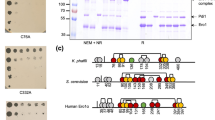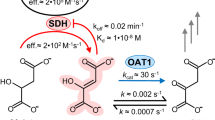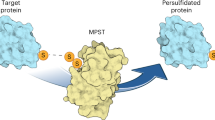Abstract
Ero1 and Pdi1 are essential elements of the pathway for the formation of disulphide bonds within the endoplasmic reticulum (ER). By screening for alternative oxidation pathways in Saccharomyces cerevisiae, we identified ERV2 as a gene that when overexpressed can restore viability and disulphide bond formation to an ero1-1 mutant strain. ERV2 encodes a luminal ER protein of relative molecular mass 22,000. Purified recombinant Erv2p is a flavoenzyme that can catalyse O2-dependent formation of disulphide bonds. Erv2p transfers oxidizing equivalents to Pdi1p by a dithiol–disulphide exchange reaction, indicating that the Erv2p-dependent pathway for disulphide bond formation closely parallels that of the previously identified Ero1p-dependent pathway.
This is a preview of subscription content, access via your institution
Access options
Subscribe to this journal
Receive 12 print issues and online access
$209.00 per year
only $17.42 per issue
Buy this article
- Purchase on Springer Link
- Instant access to full article PDF
Prices may be subject to local taxes which are calculated during checkout







Similar content being viewed by others
References
Lyles, M. M. & Gilbert, H. F. Catalysis of the oxidative folding of ribonuclease A by protein disulfide isomerase: dependence of the rate on the composition of the redox buffer. Biochemistry 30, 613–619 (1991).
Frand, A. R. & Kaiser, C. A. The ERO1 gene of yeast is required for oxidation of protein dithiols in the endoplasmic reticulum. Mol. Cell 1, 161–170 (1998).
Pollard, M. G., Travers, K. J. & Weissman, J. S. Ero1p: a novel and ubiquitous protein with an essential role in oxidative protein folding in the endoplasmic reticulum. Mol. Cell 1, 171–182 (1998).
Cuozzo, J. W. & Kaiser, C. A. Competition between glutathione and protein thiols for disulphide-bond formation. Nature Cell Biol. 1, 130–135 (1999).
Cabibbo, A. et al. ERO1-L, a human protein that favors disulfide bond formation in the endoplasmic reticulum. J. Biol. Chem. 275, 4827–4833 (2000).
Gilbert, H. F. in Mechanisms of Protein Folding (ed. Pain, R. H.) 104–135 (Oxford Univ. Press, New York, 1994).
Chivers, P. T., Prehoda, K. E. & Raines, R. T. The CXXC motif: a rheostat in the active site. Biochemistry 36, 4061–4066 (1997).
Martin, J. L. Thioredoxin—a fold for all reasons. Structure 3, 245–250 (1995).
Scherens, B., Dubois, E. & Messenguy, F. Determination of the sequence of the yeast YCL313 gene localized on chromosome III. Homology with the protein disulfide isomerase (PDI gene product) of other organisms. Yeast 7, 185–193 (1991).
Holst, B., Tachibana, C. & Winther, J. R. Active site mutations in yeast protein disulfide isomerase cause dithiothreitol sensitivity and a reduced rate of protein folding in the endoplasmic reticulum. J. Cell Biol. 138, 1229–1238 (1997).
Frand, A. R. & Kaiser, C. A. Ero1p oxidizes protein disulfide isomerase in a pathway for disulfide bond formation in the endoplasmic reticulum. Mol. Cell 4, 469–477 (1999).
Laboissiere, M. C., Sturley, S. L. & Raines, R. T. The essential function of protein-disulfide isomerase is to unscramble non-native disulfide bonds. J. Biol. Chem. 270, 28006–28009 (1995).
LaMantia, M. L. & Lennarz, W. J. The essential function of yeast protein disulfide isomerase does not reside in its isomerase activity. Cell 74, 899–908 (1993).
Frand, A. R., Cuozzo, J. W. & Kaiser, C. A. Pathways for protein disulphide bond formation. Trends Cell Biol. 10, 203–210 (2000).
Tu, B. P., Ho-Schleyer, S. C., Travers, K. J. & Weissman, J. S. Biochemical basis of oxidative folding in the endoplasmic reticulum. Science 290, 1571–1574 (2000).
Stein, G. & Lisowsky, T. Functional comparison of the yeast scERV1 and scERV2 genes. Yeast 14, 171–180 (1998).
Jämsä, E., Simonen, M. & Makarow, M. Selective retention of secretory proteins in the yeast endoplasmic reticulum by treatment of cells with a reducing agent. Yeast 10, 355–370 (1994).
Simons, J. F., Ferro-Novick, S., Rose, M. D. & Helenius, A. BiP/Kar2p serves as a molecular chaperone during carboxypeptidase Y folding in yeast. J. Cell Biol. 130, 41–49 (1995).
Lisowsky, T. Dual function of a new nuclear gene for oxidative phosphorylation and vegetative growth in yeast. Mol. Gen. Genet. 232, 58–64 (1992).
Hofhaus, G., Stein, G., Polimeno, L., Francavilla, A. & Lisowsky, T. Highly divergent amino termini of the homologous human ALR and yeast scERV1 gene products define species specific differences in cellular localization. Eur. J. Cell Biol. 78, 349–356 (1999).
Francavilla, A. et al. Augmenter of liver regeneration: its place in the universe of hepatic growth factors. Hepatology 20, 747–757 (1994).
Hagiya, M. et al. Cloning and sequence analysis of the rat augmenter of liver regeneration (ALR) gene: expression of biologically active recombinant ALR and demonstration of tissue distribution. Proc. Natl Acad. Sci. USA 91, 8142–8146 (1994).
Coppock, D. L., Cina-Poppe, D. & Gilleran, S. The quiescin Q6 gene (QSCN6) is a fusion of two ancient gene families: thioredoxin and ERV1. Genomics 54, 460–468 (1998).
Lewis, T., Zsak, L., Burrage, T. G., Lu, Z., Kutish, G. F., Neilan, J. G. & Rock, D. L. An African swine fever virus ERV1-ALR homologue, 9GL, affects virion maturation and viral growth in macrophages and viral virulence in swine. J. Virol. 74, 1275–1285 (2000).
Senkevich, T. G., White, C. L., Koonin, E. V. & Moss, B. A viral member of the ERV1/ALR protein family participates in a cytoplasmic pathway of disulfide bond formation. Proc. Natl Acad. Sci. USA 97, 12068–12073 (2000).
Hoober, K. L., Glynn, N. M., Burnside, J., Coppock, D. L. & Thorpe, C. Homology between egg white sulfhydryl oxidase and quiescin Q6 defines a new class of flavin-linked sulfhydryl oxidases. J. Biol. Chem. 274, 31759–31762 (1999).
Leea, J., Hofhausa, G. & Lisowsky, T. Erv1p from Saccharomyces cerevisiae is a FAD-linked sulfhydryl oxidase. FEBS Lett. 477, 62–66 (2000).
Faeder, E. J. & Siegel, L. M. A rapid micromethod for determination of FMN and FAD in mixtures. Anal. Biochem. 53, 332–336 (1973).
Claros, M. G. & von Heijne, G. TopPred II: an improved software for membrane protein structure predictions. Comput. Appl. Biosci. 10, 685–686 (1994).
Gerber, J., Mühlenhoff, U., Hofhaus, G., Lill, R. & Lisowsky, T. Yeast Erv2p is the first microsomal FAD-linked sulfhydryl oxidase of the Erv1p/Alrp protein family. J. Biol. Chem. 276, 23486–23489 (2001).
Hirschberg, C. B., Robbins, P. W. & Abeijon, C. Transporters of nucleotide sugars, ATP, and nucleotide sulfate in the endoplasmic reticulum and Golgi apparatus. Annu. Rev. Biochem. 67, 49–69 (1998).
Gliszczynska, A. & Koziolowa, A. Chromatographic determination of flavin derivatives in baker's yeast. J. Chromatogr. A 822, 59–66 (1998).
Pedrajas, J. R., Kosmidou, E., Miranda-Vizuete, A., Gustafsson, J. A., Wright, A. P. & Spyrou, G. Identification and functional characterization of a novel mitochondrial thioredoxin system in Saccharomyces cerevisiae. J. Biol. Chem. 274, 6366–6373 (1999).
Lisowsky, T., Lee, J. E., Polimeno, L., Francavilla, A. & Hofhaus, G. Mammalian augmenter of liver regeneration protein is a sulfhydryl oxidase. Dig. Liver Dis. 33, 173–180 (2001).
Wach, A., Brachat, A., Pohlmann, R. & Philippsen, P. New heterologous modules for classical or PCR-based gene disruptions in Saccharomyces cerevisiae. Yeast 10, 1793–1808 (1994).
Liu, H., Krizek, J. & Bretscher, A. Construction of a GAL1-regulated yeast cDNA expression library and its application to the identification of genes whose overexpression causes lethality in yeast. Genetics 132, 665–673 (1992).
Elrod-Erickson, M. J. & Kaiser, C. A. Genes that control the fidelity of endoplasmic reticulum to Golgi transport identified as suppressors of vesicle budding mutations. Mol. Biol. Cell 7, 1043–1058 (1996).
Acknowledgements
We thank J. Winther for generously providing the PDI expression plasmid, and T. Stevens for PDI antibody. Support for this work came from a grant from the National Institutes of General Medical Sciences. J.W.C. was supported by a NIH National Research Service Award, C.S.S. was supported by a NIH National Research Service Award, and A.V. was supported by a fellowship from the Gulbenkian Foundation.
Author information
Authors and Affiliations
Corresponding author
Rights and permissions
About this article
Cite this article
Sevier, C., Cuozzo, J., Vala, A. et al. A flavoprotein oxidase defines a new endoplasmic reticulum pathway for biosynthetic disulphide bond formation. Nat Cell Biol 3, 874–882 (2001). https://doi.org/10.1038/ncb1001-874
Received:
Revised:
Accepted:
Published:
Issue Date:
DOI: https://doi.org/10.1038/ncb1001-874
This article is cited by
-
Synergistic optimisation of expression, folding, and secretion improves E. coli AppA phytase production in Pichia pastoris
Microbial Cell Factories (2021)
-
Overexpression of augmenter of liver regeneration (ALR) mitigates the effect of H2O2-induced endoplasmic reticulum stress in renal tubule epithelial cells
Apoptosis (2019)
-
Identification, characterization and purification of porcine Quiescin Q6-Sulfydryl Oxidase 2 protein
BMC Veterinary Research (2017)
-
Evolutionary conservation and in vitro reconstitution of microsporidian iron–sulfur cluster biosynthesis
Nature Communications (2017)
-
Functional and structural characterization of protein disulfide oxidoreductase from Thermus thermophilus HB27
Extremophiles (2014)



